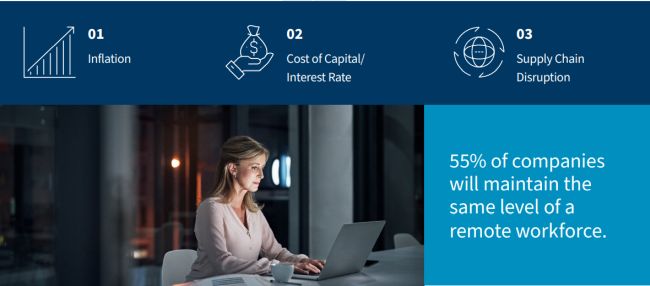Introduction
The survey focuses on capturing insights from business leaders on the challenges they face and their expectations for 2023. Working in conjunction with CFO Dive, we asked senior finance executives worldwide about the strategies and tactics they will undertake over the next 18 months to maximize financial performance and protect the bottom line. More than three hundred responses were collected from executives across North America, APAC, and EMEA, evenly split by each region.
94% of respondents cite talent attraction as a key focus over the next 18 months.
Global Highlights
GROWTH
Respondents expect slower growth for the next 18 months, with companies over $5 billion (USD) in revenues expecting the lowest growth between 1 and 10 percent. Companies with revenues between USD $1 billion and $5 billion are the most bullish on growth, predicting revenue growth between 11 and 50 percent.
CHALLENGES
The top two risks that will challenge companies in meeting their objectives across all regions were increases in inflation and interest rates/cost of capital, with more than three-quarters of respondents indicating these two factors posed either a high or medium risk.
VOLATILITY
Finance executives continue to be faced with demand volatility, supply uncertainty, and changing contract terms that impact their ability to predict. Nearly half of the respondents said that the ability to understand revenue potential was impeded by the uncertainty of how their operations could respond to demand volatility.
CFO TENURE
64.2% of respondents stated that the average tenure of a CFO in a single company was less than five years. This is an increase of 16.2% from last year, when 48% of CFOs held this belief, indicating a potential for higher CFO turnover. Of the three regions surveyed, EMEA had 73% of CFOs agree that CFO tenure at a single employer is under five years, while 60.8% of APAC and 59.2% of North American CFOs agree with this perspective.
FINANCE IMPROVEMENT
Overall, the most popular tactic for improving financial performance is to implement operational improvements, and the most prevalent challenge among all CFOs was better understanding and implementing technology.
TALENT
Finance talent remains in high demand, as 94.1% of respondents indicated that they would spend more or the same focus on talent attraction and retention over the next 18 months. Within the finance organization, financial reporting/compliance, finance technology, and accounting/controls were the three most soughtafter talent areas.
Highlights Within the Regions
NORTH AMERICA
| FINANCIAL PERFORMANCE | CFO FINANCE FOCUS | HYBRID WORKFORCE |
| With slower growth ahead for many companies, North American CFOs are driving financial performance organically (52.5%) versus through M&A (25.7%). | North American finance leaders will focus on strategic planning, cost management, and attracting and retaining talent over the next 18 months. | Only 17.8% of companies had their
employees back in the office full-time, 8.8% fully
remote, and 32.7% allowed a hybrid model of fewer
than two days per week in the office. Another
24.5% allowed their employees to work remotely
more than two days per week, while 16.2% say it
varies by office location.
Over half (54.5%) of companies will maintain the same level of a remote workforce, 18.8% will allow less, and 21.8% will allow more. |
TOP 3 CHALLENGES

EMEA
| FINANCIAL PERFORMANCE | CFO FINANCE FOCUS | HYBRID WORKFORCE |
| The majority of EMEA CFOs (57%) will look to operational improvements over the next 18 months, and one-third of companies will be cutting enterprise costs to improve financial performance. | EMEA finance leaders said they would focus on strategic planning, creating efficiencies/cutting costs, and cash flow over the next 18 months. | 21% of companies had their
employees back in the office full-time, 6% fully
remote, and 41% allowed a hybrid model of fewer
than two days per week in the office. Another 23%
allowed their employees to work from home more than two days per
week, while 9% say it varies with office location.
41% of companies have decided on less remote working in the future, compared to 22% that will allow more. |
To view the full article click here
The content of this article is intended to provide a general guide to the subject matter. Specialist advice should be sought about your specific circumstances.


